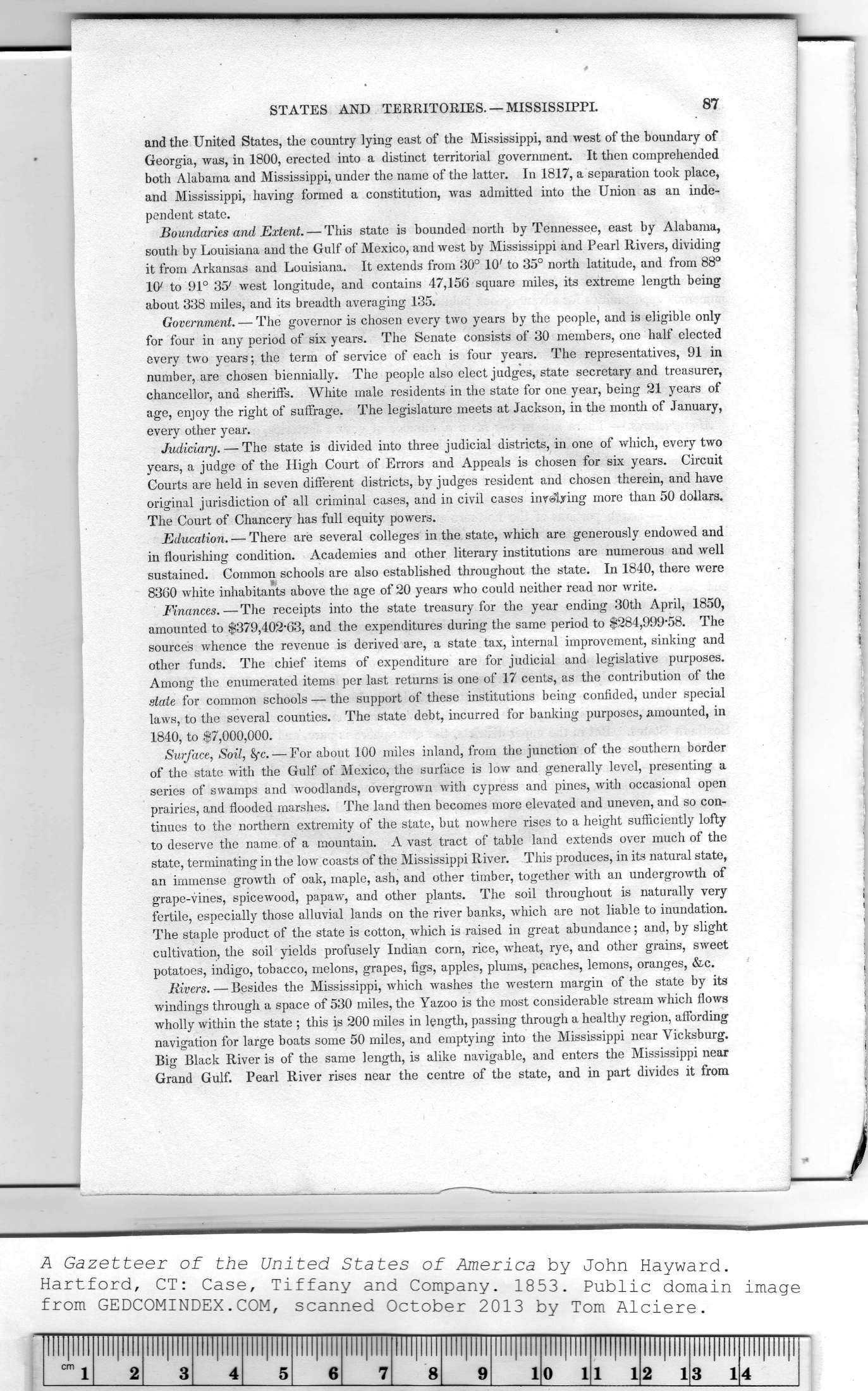|
|
Note: Ctrl and + increases the font size of the text below, Ctrl and - decreases it, and Ctrl and 0 resets it to default size.
STATES AND TERRITORIES. — MISSISSIPPI. 87
and the United States, the country lying east of the Mississippi, and west of the boundary of
Georgia, was, in 1800, erected into a distinct territorial government. It then comprehended
both Alabama and Mississippi, under the name of the latter. In 1817, a separation took place,
and Mississippi, having formed a constitution, was admitted into the Union as an inde-
pendent state.
Boundaries and Extent. — This state is bounded north by Tennessee, east by Alabama,
south by Louisiana and the Gulf of Mexico, and west by Mississippi and Pearl Rivers, dividing
it from Arkansas and Louisiana. It extends from 30° 10' to 35° north latitude, and from 88°
10/ to 91° 35' west longitude, and contains 47,156 square miles, its extreme length being
about 338 miles, and its breadth averaging 135.
Government. — The governor is chosen every two years by the people, and is eligible only
for four in any period of six years. The Senate consists of 30 members, one half elected
every two years; the term of service of each is four years. The representatives, 91 in
number, are chosen biennially. The people also elect judges, state secretary and treasurer,
chancellor, and sheriffs. White male residents in the state for one year, being 21 years of
age, enjoy the right of suffrage. The legislature meets at Jackson, in the month of January,
every other year.
Judiciary. — The state is divided into three judicial districts, in one of which, every two
years, a judge of the High Court of Errors and Appeals is chosen for six years. Circuit
Courts are held in seven different districts, by judges resident and chosen therein, and have
original jurisdiction of all criminal cases, and in civil cases inv&lying more than 50 dollars.
The Court of Chancery has full equity powers.
Education. — There are several colleges in the state, which are generously endowed and
in flourishing condition. Academies and other literary institutions are numerous and well
sustained. Common schools are also established throughout the state. In 1840, there were
8360 white inhabitants above the age of 20 years who could neither read nor write.
Finances.—The receipts into the state treasury for the year ending 30th April, 1850,
amounted to $379,402-63, and the expenditures during the same period to $284,999-58. The
sources whence the revenue is derived are, a state tax, internal improvement, sinking and
other funds. The chief items of expenditure are for judicial and legislative purposes.
Among the enumerated items per last returns is one of 17 cents, as the contribution of the
state for common schools — the support of these institutions being confided, under special
laws, to the several counties. The state debt, incurred for banking purposes, amounted, in
1840, to $7,000,000.
Surface, Soil, fyc. — For about 100 miles inland, from the junction of the southern border
of the state with the Gulf of Mexico, the surface is low and generally level, presenting a
series of swamps and woodlands, overgrown with cypress and pines, with occasional open
prairies, and flooded marshes. The land then becomes more elevated and uneven, and so con-
tinues to the northern extremity of the state, but nowhere rises to a height sufficiently lofty
to deserve the name of a mountain. A vast tract of table land extends over much of the
state, terminating in the low coasts of the Mississippi River. This produces, in its natural state,
an immense growth of oak, maple, ash, and other timber, together with an undergrowth of
grape-vines, spicewood, papaw, and other plants. The soil throughout is naturally very
fertile, especially those alluvial lands on the river banks, which are not liable to inundation.
The staple product of the state is cotton, which is raised in great abundance; and, by slight
cultivation, the soil yields profusely Indian corn, rice, wheat, rye, and other grains, sweet
potatoes, indigo, tobacco, melons, grapes, figs, apples, plums, peaches, lemons, oranges, &c.
Rivers. — Besides the Mississippi, which washes the western margin of the state by its
windings through a space of 530 miles, the Yazoo is the most considerable stream which flows
wholly within the state ; this is 200 miles in length, passing through a healthy region, affording
navigation for large boats some 50 miles, and emptying into the Mississippi near Vicksburg.
Big Black River is of the same length, is alike navigable, and enters the Mississippi near
Grand Gulf. Pearl River rises near the centre of the state, and in part divides it from
A Gazetteer of the United States of America by John Hayward.
Hartford, CT: Case, Tiffany and Company. 1853. Public domain image
|
